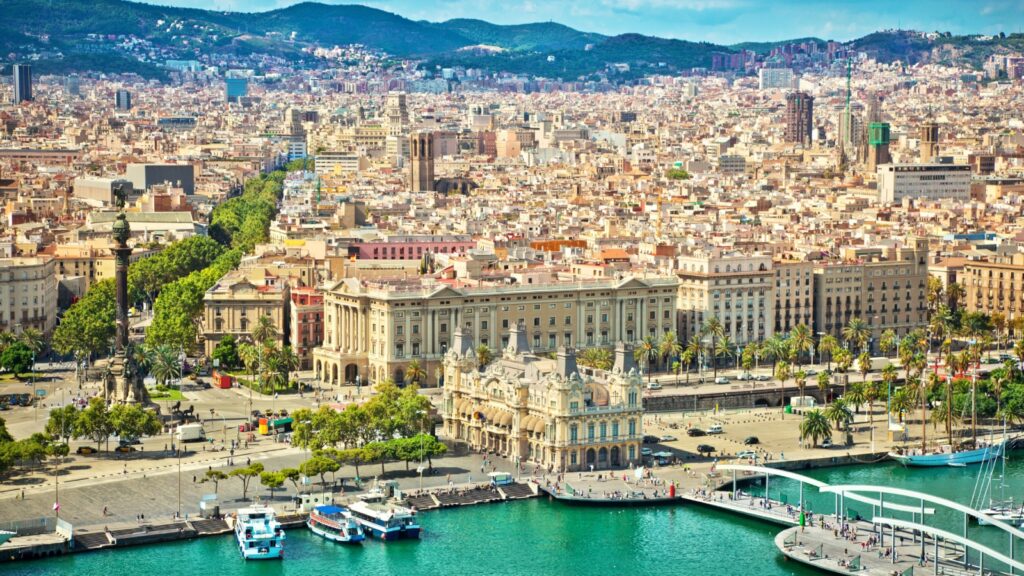Ensuring your devices work in Denmark requires knowledge of local outlets and voltage compatibility....
Travel Guides
Spain, with its vibrant cities, Moorish architecture, and sun-drenched beaches, is a top destination for travelers. From the art-filled streets of Madrid to the Gaudí masterpieces in Barcelona and the flamenco rhythms of Seville, it offers a mix of history, culture, and cuisine. But the question remains: what to see first? To help you decide, I've […]


Spain, with its vibrant cities, Moorish architecture, and sun-drenched beaches, is a top destination for travelers. From the art-filled streets of Madrid to the Gaudí masterpieces in Barcelona and the flamenco rhythms of Seville, it offers a mix of history, culture, and cuisine. But the question remains: what to see first? To help you decide, I've created this Spain itinerary guide.
Whether you’re here for a quick city break or a month-long exploration, Spain has something for everyone. This guide will help you navigate the best itineraries based on your time, ensuring you experience the essence of Spain without feeling overwhelmed.
Start your morning at La Sagrada Família, a basilica that has been under construction since 1882 and stands as Gaudí’s most ambitious masterpiece. For the best experience, book a timed-entry ticket (€33) months in advance via the official website, aiming for an 8-10 AM slot to avoid crowds.
From there, wander to Park Güell, a UNESCO World Heritage Site. The paid Monumental Zone (€18) features mosaic-covered benches and the iconic dragon fountain, but the free lower gardens—like the serene Austrian Gardens—offer quieter paths and fewer tourists.
In the evening, head to Barceloneta Beach to unwind on golden sands with views of the sail-shaped W Hotel. Rent a bike (€5 for 2 hours) to glide along the beach boardwalk to Port Olímpic, then toast the sunset with a clara (beer with lemon). For dinner, visit Can Solé, a family-run restaurant since 1903, celebrated for its paella de mariscos. Remember, locals dine late, so aim for an 8:30 PM meal.
A quick 40-minute train ride transports you to Girona, a city where history and fantasy collide. Walk the medieval city walls for panoramic views of terracotta rooftops and the Onyar River—scenery that doubled as Braavos in Game of Thrones. The city’s mix of ancient stones and cinematic magic makes every corner feel like a scene from an epic tale.
Go to Madrid via high-speed train (2.5 hours, prices start from around €30 one way). Dive into regal grandeur at the Royal Palace (€13), then soak up masterpieces by Goya and Velázquez at the Prado Museum—free entry 6–8 PM Mon–Sat. At dusk, savor roast suckling pig at Casa Botín (€15–25/dish), the world’s oldest restaurant since 1725, then wander Plaza Mayor under its golden lantern glow.
Just 33 minutes by Renfe’s high-speed train from Madrid’s Atocha Station (€13–20 round-trip, hourly departures), Toledo rises like a medieval mirage atop the Tagus River. Declared a UNESCO World Heritage Site in 1986, Spain’s former capital is a labyrinth of Moorish, Jewish, and Christian influences, earning it the nickname “City of Three Cultures.”
Begin at the Catedral Primada de Toledo (€12), a 13th-century Gothic marvel adorned with 750 stained-glass windows and El Greco’s The Disrobing of Christ. Next, visit the El Greco Museum (€3), set in a reconstructed 16th-century home. Wander at the cobbled alleys like Callejón del Diablo (“Devil’s Alley”), or pop into Santo Tomé Church (€3).
Wrap up your night at Corral de la Morería (€96 for the show), a legendary flamenco venue that’s been electrifying audiences since 1956. This isn’t just a performance—it’s a cultural institution. Picasso sipped sherry here, and Nobel laureate Gabriel García Márquez once called it “the cathedral of flamenco.”
Begin your day at the Real Alcázar (€13.50), a UNESCO World Heritage Site and one of Europe’s oldest royal palaces. Wander through sun-drenched gardens like the Patio de las Doncellas, where geometric tilework and bubbling fountains reflect centuries of Islamic and Renaissance artistry.
Next, head to Seville Cathedral, the world’s largest Gothic church. Climb the Giralda Tower (free with cathedral entry), a 12th-century minaret converted into a bell tower. Its unique ramp (no stairs!) leads to panoramic views of Seville’s terracotta rooftops and the Guadalquivir River.
Cap your day at Plaza de España, a semicircular marvel built for the 1929 World’s Fair. As the sun dips, its ceramic-tiled alcoves—each representing a Spanish province—glow amber. Rent a rowboat (€6/35min) to paddle the canal, or simply linger as street musicians serenade the twilight.
In the morning, start at the Mosque-Cathedral (€13), a UNESCO World Heritage Site. Then, in the afternoon, wander the Juderia (Jewish Quarter), a maze of whitewashed alleys where the Synagogue of Córdoba (€0.30 entry)—one of Spain’s few surviving medieval synagogues—still stands.
Your first stop is the Alhambra. This UNESCO-listed complex—part palace, part fortress—is a testament to the Nasrid dynasty’s ingenuity. Wander the Nasrid Palaces, where stucco walls drip with Arabic calligraphy (“Only God is victorious”), and the Generalife Gardens.
Descend into the Albaicín, a medieval Muslim quarter and UNESCO site. Enjoy the walk through the labyrinth of whitewashed houses, hidden gardens, and teahouses serving mint-infused “té moruno” (Moroccan green tea). For the ultimate view, hike to Mirador de San Nicolás at sunset, where the Alhambra glows pink against the mountain range of the Sierra Nevada.
Extend your trip to include northern Spain’s charm and coastal beauty, building on the 7-day itinerary for a deeper dive into the country’s diverse landscapes and culture.
Step into the City of Arts and Sciences, a jaw-dropping complex that looks like it’s straight out of a sci-fi movie. Start at the Hemisfèric, a giant eye-shaped building where you can watch IMAX films, laser shows, or planetarium displays.
Next, bike the Turia Gardens—a 9km green ribbon in a dried-up riverbed—past orange groves and playgrounds (rentals: €8/day). Cap your day at La Pepica, a seafront icon since 1898, where Hemingway ate paella valenciana (€18)—saffron rice with rabbit, chicken, and snails—invented here in the 1800s.
Afterward, relax at the Umbracle, a palm-tree-lined promenade dotted with sculptures and blooming flowers. By day, it’s a shady escape for photos; by night, it lights up for open-air concerts.
Fly 1.5 hours to Spain’s Basque gem. Soak up the golden sands of La Concha Beach, then hike Monte Urgull for sweeping bay views from its 12th-century fortress. At dusk, feast on avant-garde pintxos like smoked cod “clouds” (€3–5) at Bar Zeruko, sipping txakoli (slightly sparkling wine) as you hop the old cobblestone bars. With more Michelin stars per capita than Paris, San Sebastián is the perfect marriage of wild Atlantic beauty and culinary genius.
Start at the Guggenheim Museum (€6–15), where iconic modern art and the Nervión River’s shimmer steal the spotlight. Then, stroll Casco Viejo (Old Town), a maze of medieval lanes packed with pintxos bars and landmarks like Santiago Cathedral. End your day in Azurmendi (€150 per person), a 3-Michelin-starred wonder where Chef Eneko Atxa crafts 20 courses of edible art.
For travelers craving the full spectrum of Spain—vibrant cities, timeless villages, and sun-soaked beaches—the 14-day itinerary delivers it all in one seamless, unforgettable journey.
Drive two hours from Seville into Andalusia’s rugged heart to Ronda, a town perched atop a 390-foot gorge that seems to defy gravity. Cross the Puente Nuevo, an 18th-century stone bridge straddling the El Tajo canyon—its vertigo-inducing drop once hid a prison, now a museum whispering tales of bandits and rebellion.
Nearby, the Bullring Museum (€9) reveals Ronda’s legacy as the birthplace of modern bullfighting, where matadors like Pedro Romero turned spectacle into art. As dusk paints the cliffs gold, retreat to a parador—Spain’s network of historic hotels—where your room clings to the canyon edge, offering views so profound that even Hemingway rhapsodized about them.
Just 1.5 hours from Seville, Málaga—once a gritty port—has blossomed into Andalusia’s cultural darling. Begin at the Picasso Museum (€12), housed in a 16th-century palace where 285 works trace the artist’s journey from hometown prodigy to global icon.
Next, ascend to the Alcazaba (€10), an 11th-century Moorish fortress-palace where geometric archways frame views of the Mediterranean. Finally, unwind at Playa de la Malagueta, a lively urban beach where sunbathers lounge under straw umbrellas (€14). Unlike the Costa del Sol’s resort crowds, this spot pulses with local energy.
This lively urban beach in Málaga is a local favorite, where golden sands meet calm Mediterranean waters. Rent a straw umbrella (€20/day) to lounge under the sun, paddleboard (€30/hour) past fishing boats, or join a game of beach volleyball. The promenade buzzes with joggers, cyclists, and families, while the iconic La Farola lighthouse adds a postcard-perfect backdrop.
Spend your last day back in Barcelona. Wander Passeig de Gràcia for final souvenirs, then cap your trip at Tickets Bar—Albert Adrià’s Michelin-starred gem—for a €150 tasting menu. Make sure to book months ahead—this is Spain’s most sought-after table.
To make your trip smooth, here are essential tips:
Spain has a well-developed internet infrastructure with widespread 4G and growing 5G coverage across major cities and tourist destinations. Public WiFi is available in hotels, cafes, and public spaces, but it can be unreliable and unsecured.
For travelers, using an eSIM is a convenient and cost-effective alternative to traditional SIM cards and expensive roaming, providing seamless connectivity without needing a physical SIM swap. However, coverage may vary in rural or remote areas, so choosing a provider with strong network partnerships is essential.
| Provider | Pros | Cons | Price | |
| Holafly | Unlimited data, 24/7 customer support | Data sharing unavailable | From $6.90 | |
| Truphone | Reliable global coverage, easy setup | Limited data plans | Varies | |
| TravelSIM | Affordable short-term plans | Limited data allowance | From $10.82 | |
Lastly, when traveling to Spain, it’s also important to consider electrical compatibility. Spain uses Type C and Type F plugs with a 230V/50Hz power standard, so depending on where you're coming from, you might need a plug adapter or voltage converter to keep your devices charged and connected.
Yes, English is widely spoken in Barcelona, especially in tourist areas, hotels, and restaurants. However, the primary languages are Catalan and Spanish.
Both cities are generally considered safe for travelers. However, petty theft (like pickpocketing) is more common in Barcelona’s crowded spots, such as La Rambla or the metro stations.
Tipping isn’t mandatory but is appreciated for good service:
Restaurants: Round up the bill or leave 5–10%.
Taxis: €1–2 for short rides.
Bars: No need unless table service is provided.
Unlike in the U.S., tips are modest and not expected in casual settings.
The Alhambra in Granada tops most lists. This stunning Moorish palace and fortress complex, a UNESCO World Heritage Site, draws millions yearly.
Depends on your interests:
Beaches & nightlife: Costa del Sol (Marbella) or Ibiza.
Culture & history: Granada (Alhambra), Seville (Real Alcázar), or Toledo.
Scenic beauty: Basque Country (San Sebastián) or Ronda’s cliffside views.
City vibes: Barcelona for art, Madrid for museums and food.
For a mix of everything, Andalusia (Seville, Granada, and Córdoba) offers iconic Spanish charm.

